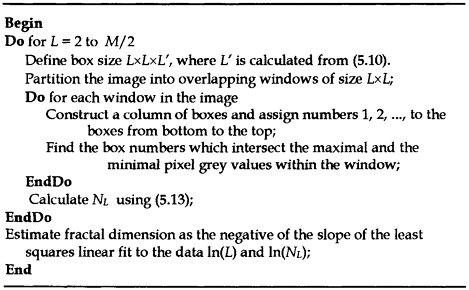111.
| [Cover] [Contents] [Index] |
Page 198

Figure 5.7 Fractal dimension estimation using differential box counting method.
At measurement scale L, the process starts by dividing the image into overlapping windows, with each window being of size L×L. For each window, take the grey level values at the four corner pixels of the window, and then interpolate a centre value by averaging. When the four corner points are connected to this interpolated centre point, four triangles will result. The next step is to sum the triangular areas within the image assuming that we are dealing with an intensity surface where the pixel values form the third dimension z, as before. This process is repeated for different scales L, and the fractal dimension D is estimated by calculating the negative of the slope of the least squares line relating ln(L) and {-ln(total triangular area at scale L)}.
The example in Figure 5.8a shows a 3×3 window and the resulting interpolated central points and four triangular areas. The triangular area with vertices a, d, c, as shown in Figure 5.8b, is obtained from:
 |
(5.14) |
where  denotes the Euclidean distance between vertices a and d, and can be computed immediately because the co-ordinates of a and d in three-dimensional space are already known. To obtain
denotes the Euclidean distance between vertices a and d, and can be computed immediately because the co-ordinates of a and d in three-dimensional space are already known. To obtain  , one possible approach is firstly to set
, one possible approach is firstly to set  =x and by solving following equation (based on fundamental triangular theory) to calculate
=x and by solving following equation (based on fundamental triangular theory) to calculate  :
:
| [Cover] [Contents] [Index] |
EAN: 2147483647
Pages: 354